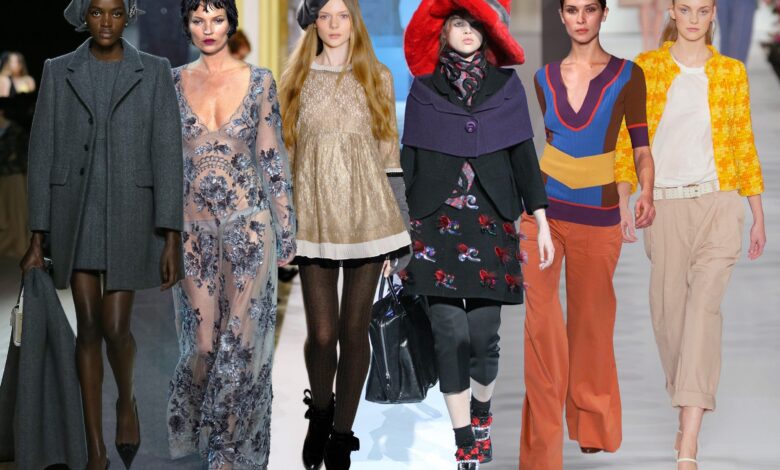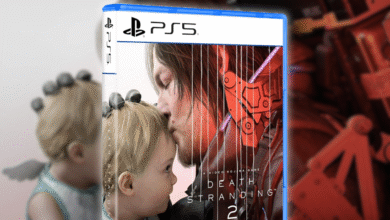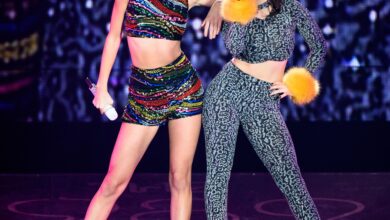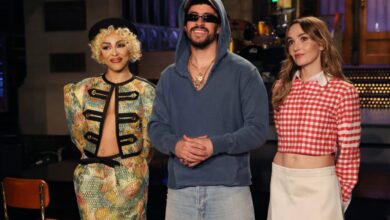The Best Marc Jacobs Shows of All Time—According to Vogue’s Editors

From his early days at Perry Ellis, through his 14-year stint at Louis Vuitton, to his post-pandemic era, Vogue’s December guest editor Marc Jacobs is responsible for decades of memorable shows. After much internal discussion, we’ve rounded up our personal favorites here, and arranged them in chronological order. Together they paint a picture of a showman extraordinaire and a designer of many passions, one whose talents span the “no-irony” elegance of mid-century sportswear and “Hot Topic-meets-Victorian-mourning dress high goth fantasia.” And much more, of course. Having perfected the art of the runway 180 long ago, Jacobs has channeled everyone from Edie Sedgwick to Blair Waldorf, and riffed on the legacies of Coco Chanel, Yves Saint Laurent, and other greats, yet he remains delightfully, engagingly, unforgettably himself.
Perry Ellis, spring 1993 ready-to-wear
Photo: Condé Nast Archive
Sarah Mower, Perry Ellis Spring 1993
I think Marc’s ground-shaking Perry Ellis “Grunge” show must have been in the brand’s showroom. I do remember a power-suited PR firmly ordering me to a seat so far back, it was practically in the corridor. So there I was, a wide-eyed newbie British Vogue fashion features editor, a stranger in town who clearly meant less than nothing. But even from that far back (to be honest, I defied protocol and slid over to stand against a wall), the wave of emotion was unfakeable; this was a young designer, in cahoots with his cool gang of girls, who was putting on one of those occasions when the fashion zeitgeist shifts before your very eyes.
Instantly, Marc’s layerings of flower and fruit-printed dresses, scrappy beanie hats, ratty striped knits, hip-knotted flannel shirts, and army boots felt completely real and viscerally relatable to me. I’d barely heard of grunge and Nirvana, and didn’t know where Seattle was. “Smells Like Teen Spirit” had only been released three months earlier. But coming from London, where rave culture was raging in fields and derelict warehouses, and girls with unwashed center-parted hair were slopping round in vintage dresses and holey cardigans—this all felt totally recognizable. Especially as it was being acted out by that little known 18 year old Londoner Kate Moss, with Naomi Campbell, Kristen McMenamy, and the great supers Christy Turlington, Helena Christiansen, Yasmeen Ghauri, Tyra Banks, et al. They were really enjoying themselves—suddenly not so much artificially transformed as looking authentically their own age, for a change.
I was applauding and probably laughing loudly there at the back. That was not the reaction amongst the women of the press, I noticed. Strangely, they’d snapped their notebooks shut and were herding grimly toward the elevators. Famously, their reviews panned the collection, and department store power-players rejected it. The amazing long-haired Marc, channeller of his generation, was fired soon after.
What the establishment couldn’t take in real time was the shock of witnessing the precipitous change from one decade to the next. It was 1991: here were the glam, moneyed “executive woman” looks and values of the New York ’80s being overthrown by the scrappy, unmade-up, anti-glamour waif-generation energy of the coming ’90s. Vogue, being pro-fashion and excited by every aesthetic creative leap into the future, loved it, of course. Thanks to Marc Jacobs, the door had been opened to a whole new kind of model, a new young breed of hair and makeup people, stylists, and photographers. A lot of them piled into New York from London.
Anyway, the moral of that day still stands. The conservative reactionaries, fearful that “no woman wants to dress like that” were completely wrong. Soon everyone wanted long print dresses—liberation from trussed-up mini-skirted power suits—and everything Marc had shown that day was absorbed, normalized, and making fortunes for high street retailers. His grunge collection has been periodically revisited and requoted, sometimes by himself, ever since. Moral, clause two: Fashion needs the daring and controversy stirred up by designers who are saying important stuff about the times we’re living in, or it goes stale and boring. On that day, Marc Jacobs was marked out as one of the few capable of doing that. Seeing him prove it for the first time was an unforgettable piece of good luck.
Nicole Phelps, Spring 2002
This show took place in the evening of September 10, 2001. When the last model walked off, the backstage wall parted for an after-party. We were in a clear plastic tent on a pier in the Hudson River; for a lot of us it was the last time we saw the Twin Towers still standing. Though I’ve loved countless Marc shows over the years, the timing of this one makes me hold my memories of it more dearly. I was a young , highly impressionable fashion editor making not much money; I could just about rationalize buying the denim in his new Marc by Marc Jacobs diffusion line, if I saved up. But I remember wanting the rainbow jersey dresses in this collection desperately, even though they were far out of reach. Looking back at them again, I see Marc’s nods to Stephen Burrows’s magic colors and fluttery hems; as a fashion diehard, he has a real genius for synthesizing the vibe of a time and the spirit of another designer he admires. I never did score one of those dresses, but Marc’s early 21st century take on the 1970s shaped the way I prefer to dress to this day: a clingy knit sweater and flared pants, like Erin Wasson wears here, are still a go-to look for me.
Marc Jacobs, fall 2002 ready-to-wear
Photo: Getty
José Criales Unzueta, Fall 2002
I always loved when Marc riffs off the way people dress in New York. I think the collections in which he balances the specificity of his taste with the pragmatism of a New Yorker have always been his most compelling, and fall 2002 is to me the perfect example. Here I love the cocktail dresses layered over tees and worn with boots and scarves, and I think the menswear is particularly great. I miss Marc’s eye on menswear—his personal style has always been fantastic and inspiring to me.
Marc Jacobs, spring 2005 ready-to-wear. Photo: Marcio Madeira
Tiziana Cardini, Spring 2005
I’ve attended countless MJ shows, both under his own label and during his tenure as creative director at Louis Vuitton (a much-missed time, btw). Every show was an absolute joy, and one of the season’s highlights—the best front rows, the best set-ups, always thrilling even when they started awfully late with editors leaving in exasperation. I never did. Missing one of his shows was unthinkable; the thrill of surprise was a true gift, anticipation building as if we were attending the latest Broadway premiere, the stage performance of a beloved musician, or the screening of a much anticipated blockbuster. And every collection offered something irresistible for the wardrobe—pieces you couldn’t wait to get your hands on. Take this tweed jacket from spring 2005: sunny, radiant, and fun—a cheeky twist on the classic Chanel jacket that I just couldn’t resist. It was love at first sight—a sentiment rather rare these days I’m afraid. Paired with relaxed chinos, it was an everyday gem. It still holds a cherished spot in my closet.
Marc by Marc Jacobs, spring 2007 ready-to-wear. Photo: Marcio Madeira
Irene Kim, Marc by Marc Jacobs Fall 2007
My first real intro to Marc Jacobs was when I watched Gossip Girl as a middle schooler. Marc Jacobs got a lot shout-outs on the show, especially since Blair Waldorf’s mom was constantly competing with the designer at New York Fashion Week. The first season is my favorite era of Blair’s fashion and it’s thanks to the show’s costume designer putting Blair in various Marc by Marc Jacobs looks from both his spring and fall 2007 collections. My dream outfit from that first season, this metallic gold lace mini dress, which was topped by a very chic capelet, appeared on the Thanksgiving episode. Even to this day I would still wear it (along with anything from this collection) if I could.
Marc Jacobs, spring 2008 ready-to-wear. Photo: Marcio Madeira
Laird Borrelli-Persson, Spring 2008
Marc Jacobs’s backwards show of spring 2008 became one of those inflection points in fashion culture for reasons of time. The show, presented at the Lexington Avenue Armory, began at 11:03, more than two hours after its scheduled start, which enraged many in the audience, including Suzy Menkes, who jokingly said she wanted to “strangle the designer.” Time and sequence were among the themes of the show which opened with the designer’s bow and proceeded backwards. The many lingerie pieces seemed to refer to the act of (un)dressing; it was as if the models were caught in a candid moment before going out. Jacobs told Nicole Phelps that they were “cartoon versions of all the women I know.” A fine description, as it captures the ability to rewind (film). The surreal accessories, like the heel-less shoes could also be described as cartoonish; they certainly were smile inducing.
Marc Jacobs, fall 2008 ready-to-wear
Photo: Getty
Laia Garcia Furtado, Fall 2008
Marc Jacobs’s fall 2008 show remains one of my all-time favorites. At the time, the designer offered no platitudes and no clues as to what inspired a collection that seemed to come from a hundred places at once; the 18th century tri-corner hats, the silhouettes inspired from 1940s day dresses mixed with a dose of 1980s drama—a bold oversized shoulder, a silver lightning bolt, an aerobics-inspired chunky headband. The best shoes from the collection were deconstructed loafers: peep-toe penny loafers where the penny slot was another cutout that exposed the skin and the heel was curved and missing a chunk; the best bag from the collection was a blueish-gray clutch with a mid-century car motif collaged on it. Big chunky silver cuffs curved like a bell that held huge pearls inside. The color palette was mostly pastels—dusty colors like they might emerge from the Super-8 montage of your brain, not sweet ones—contrasted by faded, dulled bronzes and shiny silver, and there was a heavy emphasis on textures; velvets, lurex, corduroys, secretly nubby soft wools. It is a collection that is truly timeless because it never belonged to any time to begin with. I still desire it all.
Marc Jacobs, fall 2010 ready-to-wear
Marcio Madeira / FirstView.com
Virginia Smith, Fall 2010
Deciding my favorite Marc Jacobs show is no easy feat… Spring 2004 was certainly memorable as I was nine months pregnant and would have my son 10 days later. It was late, hot, and even Marc’s number-one fan, Grace Coddington, questioned whether it was a good idea for me to attend. Fall 2012 was another favorite with its madcap mix of pilgrims-by-way-of-Dr. Seuss. But the one collection that has stayed with me the most is fall 2010. From the opening looks in shades of tonal grays, I was completely hooked. Serenely chic without trying too hard, this was a collection of pieces I wanted in my closet. I did splurge on the perfect navy peacoat with mismatched diamante buttons – one of which I lost and the MJ team kindly sent me a replacement. Looking back at this show almost 15 years later, I’m still enamored with its perfect take on a relaxed, effortless way to dress. I only regret that I don’t still have that jacket.
Marc Jacobs, spring 2011 ready-to-wear
Monica Feudi / GoRunway.com
Hannah Jackson, Spring 2011
The early 2010s marked the genesis of my interest in fashion, and Marc Jacobs was the gateway. Every month, I would tear his Juergen Teller-shot ads out of Teen Vogue, plastering my closet door with photos of frizzy-haired models in enormous sunhats and bug-eyed glasses. The ’70s-inspired spring 2011 collection—which Jacobs told Vogue’s Nicole Phelps was inspired by Naomi Campbell’s birthday party in Cannes—was my favorite: With a rich palette of orchid, dusty pink, brick red, and marigold, he told a vivid tale through his satin suits, gauzy dresses, and sculptural floral accents. From there, I was hooked on fashion—always holding a special place in my heart for Marc Jacobs.
Marc Jacobs, fall 2012 ready-to-wear
Marcus Tondo / GoRunway.com
Mark Guiducci, Fall 2012
In February 2012, I was brand new to Vogue and crashed this Marc Jacobs show, riding the coattails of a benevolent senior editor. It was the most fully realized Fashion-with-a-capital-F show I’d ever seen. I remember recognizing Lindsey Wixson by her lips alone, despite the fur hat hiding the rest of her face—model by metonymy. That season, all those Marc chapeaux came through the office so Grace Coddington could style Lady Gaga for our 120th anniversary September cover story, each one like a fabulous, floppy Faberge egg. Seeing how those hats went from the runway to the printed page was fashion magic. I was hooked.
Marc Jacobs, fall 2012 ready-to-wear
Marcus Tondo / GoRunway.com
Chloe Malle, Fall 2012
I loved the fall 2012 collection for its Mad Hatter kooky pilgrim shoes and the amazing Rachel Feinstein-designed paper set. It was all the magic we love from Marc. It was one of his first shows I ever attended and I remember wishing I could write something about the shoes so I could use the pun, “One man loved the pilgrim sole on you.” I guess this is my moment!
Marc Jacobs, spring 2013 ready-to-wear
Yannis Vlamos / GoRunway.com
Luke Leitch, Spring 2013
“Every time I try to make it faster and faster,” Marc Jacobs told us backstage afterwards: “My dream is a show that lasts for one minute: I’d love to have it over before everybody is seated.” Phew! Like all his shows of this period, spring 2013 started almost to the minute of its start time (8pm) at the Armory. And it was all over seven minutes later. Edie Sedgwick styling and Bridget Riley stripes dominated a show that unfolded on a mirrored isosceles triangle catwalk. It was a very conscious repudiation of the languidly elaborate Cat In The Hat 1920s romance of the show that came before it, a sweepingly clean exploration of mid-century modernism with a markedly Marc twist. According to my notes he said: “Last season was very romantic, very fairytale: so this season I wanted to do something very brutal, very sexy, and very straightforward. No romance, no emotion, just real power and force. We wanted the girls to have sex appeal without them being vulgar or out there. It was about coolness as opposed to an ass-up sex appeal.” He added: “It was a change of spirit, a change of attitude. Which is what we do so you guys don’t get bored.” I remember being anything but bored—at this point Jacobs was consistently the hands-down highlight of the New York shows—as we raced out afterwards to catch the flight back to London.
Louis Vuitton, fall 2013 ready-to-wear
Yannis Vlamos / InDigital | GoRunway
Christian Allaire, Louis Vuitton Fall 2013
I will forever be obsessed with Marc Jacobs’s Louis Vuitton, and I think about his fall 2013 collection for the label constantly. Transforming his runway into a makeshift hotel, models emerged in various states of undress—in chic PJs, sexy negligees, or lace slip dresses—with fancy satin or embellished coats thrown on top. Jacobs accentuated the looks with sky-high ankle twister heels, and the house’s signature bags—like the Speedy and the Pochette—were designed in plushy furs. It all felt so Old Hollywood and retro, right down to the short brown wigs that models like Kate Moss and Cara Delevingne donned. But it also feels just as fresh and elegant today as it did more than a decade ago.
Marc Jacobs, fall 2016 ready-to-wear
Photo: Monica Feudi / Indigital.tv
Liam Hess, Fall 2016
My favorite Marc Jacobs moments are when he takes a bunch of references that make absolutely no sense on paper, but through his strange, alchemical imagination are transformed into an unexpectedly cohesive whole. Few collections embody that spirit quite like the Hot Topic-meets-Victorian-mourning dress high goth fantasia of his fall 2016 outing, which appeared to variously pay homage to Edward Gorey illustrations, the Marchesa Luisa Casati, Beetlejuice’s Lydia Deetz, Gene Simmons, and multiple female Disney villains all in the same breath. Looking back, it’s impossible not to be dazzled by the sheer technical mastery of it all—the laser-cut leather, the delicate spider web embroideries, the hybrid jersey and crochet sweatshirts, the plumes of iridescent feathers sprouting from Kendall Jenner’s shoulders—but also its dark, seductive glamour, with those wildly wonky proportions and riotous combinations of textures making you want to reach out and run your hand across every look. (Not to mention, it marked the debut of the Kiki boot, a design that’s still going strong eight years later.) And the casting? Not just a who’s who of top models, but Lady freaking Gaga! In my eyes, it’s Marc’s madcap genius at its very best.
Marc Jacobs, fall 2017 ready-to-wear
Photo: Umberto Fratini / Indigital.tv
Leah Faye Cooper, Fall 2017
Whenever I look back on this collection, I get the same sense of excitement I did the first time I saw it. The short dresses, the high boots, and the fur-collar coats all exude a boldness and flair for the dramatic that resonates with me, and is also quintessential Marc Jacobs. I love the hip-hop influences, too; bling-y jewelry, slouchy silhouettes, and a styling of casual pieces that is fit for a late night out!
Marc Jacobs, fall 2020 ready-to-wear
Photo: Courtesy of Marc Jacobs
Mark Holgate, Fall 2020
Oh for sure there were other contenders. The very first Marc Jacobs show I went to, for instance—fall 1999: an ode to the 1970s—which introduced me, when I visited him and his stylist Venetia Scott at his Spring Street studio for a preview, to a new term to describe something approvingly: kicky. Or the fall 2012 collection with his fantasia of Gibson Girls meets East Village iconoclasts walking across a dreamlike Rachel Feinstein set. But nothing, for me, has ever quite topped fall 2020, held at the New York Armory up on Park Avenue. Marc has constantly used that space with all the verve and flair of a Broadway maestro: the endlessly inventive reconfigurations of chairs in a bare-boarded cavernous room somehow always magically reimagined. And never more so here: The show had been choreographed by Karole Armitage, with models—including Miley Cyrus—walking around us and past us and beyond us in exquisite graphic formations. And the clothes! This was Marc paying homage to the elegance and precision of American fashion circa the likes of Norman Norell or Pauline Trigère. No irony, nothing wink-wink: Just a pure love and respect for the art of making clothes—and few make clothes better than Marc. This look embodies it all for me: All American Seventh Avenue gray herringbone wool for a coat and dress combo, worn with a matching headscarf which was pure Mica Ertegun or Chessy Rayner. I’ve no real idea what exactly was in Marc’s head when it came to designing this particular look, but I can tell you what was in mine: The absolute dream of New York.


